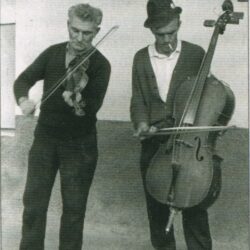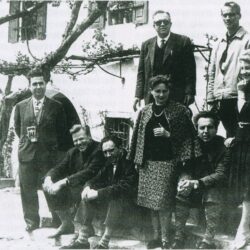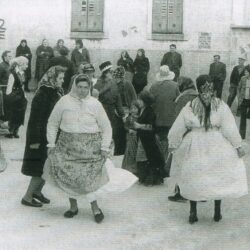Rezija: Folk Songs and Instrumental Music in the Resia Valley
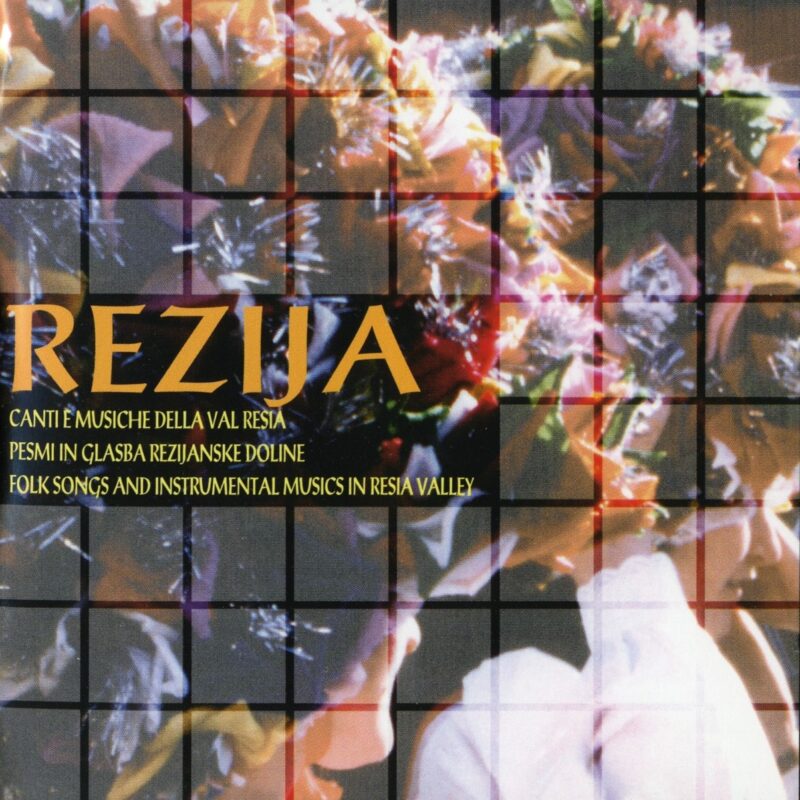
Recorded: Uccea, 1962, 1’40”
Sung by: Agata Siega “Meu”

Sveti Santilawdəć
jë rudi šow nu ökow.
Ë došow nu prat paklön.
Zapïskow nu zatrombatow.
Paklo t’ë gnalo w proga.
Oćo t’ë gnalo h kraju.
“Ka stë falawow, vï oća?”
“Si dëlow perït anu nodar.
Ta böga a si bögew,
ta bogata si bogatew.”
Zapïskow nu zatrombatow.
Paklö t’ë gnalo w proga.
Matër t’ë gnalo h kraju.
“Kostë folala matə”
“Si dëlala uštërä,
si mišala wodo tami vïno.”
Zapïskow nu zatrombatow
Paklö t’e gnalo w proga,
bratra dwa t’ë gnalo h kraju.
“Ko sta folale bratre?”
“Swa vinašala farna ti judi
njän jimita se zama,
ka šemo jte wun paravïž!”
Saint Santilavdić / walked and cried. / He came to hell. / He whistled and trumpeted. / Hell was going to dash to pieces. / Father was driving to the edge. / “What was your sin, father?” / “I was a land surveyor and a notary. / I impoverished the poor. / I enriched the rich.” / He whistled and trumpeted. / Hell was going to dash to pieces. / Mother was driving to the edge. / “What was your sin, mother?” / “I was an innkeeper. / I mixed wine and water.” / He whistled and trumpeted. / Hell was going to dash to pieces. / Two brothers were driving to the edge. / “What was your sin, brother?” / “We slandered people.” / “Now clutch at me! / We will go up in the heaven!”
Recorded: Uccea, 1962, 2’47”
Sung by: Agata Siega, Anna di Lenardo, Anna Siega
1 Lipaj ma na Banërina,
lipaj ma na Banërina, la la la la,
jo le le le lipaj ma na Banërina!
2 N’ë rüdi snëga basana..
3 Nu onjan tant an prïdi plaz..
4 Ke an pərnaša körəna..
5 Ću rejše jit te körəna..
6 Liköj no rüso rožico..
My mountain Banera is beautiful, / my mountain Banera is beautiful, / lalala, jo le lele / my mountain Banera is beautiful. // It is always covered with snow … // But now and then a snowslide comes … // and brings the roots … // I would rather eat roots … // Than that yellow small rose …
Recorded: Oseacco, 1982, 3’04”
Sung by: A group of women
1 Da pa Ćanen ë se zmudow,
da pa Ćanen ë se zmudow, la la la la,
Jo li li le, da pa Ćanen ë se zmudow, la la la
2 Ë gaw to bilo srakico…
3 Anu bragesa zalana…
4 Nu ta višïta rožica…
5 Ta bila nu ta čarnjala…
6 Anu ta rüsa zmišana…
Kanin has changed its clothing, lalalala, / Jolilile, Mount Kanin has changed its clothing, lalalala. // It put on a white shirt … // And green trousers … // With flowers sewn on … // White and red … / And yellow ones of all kinds…
Recorded: Gniva, 1963, 2’48”
Sung by: Maria Copetti, Luigia di Floriano
1 Da göra ta Ćanïnawa,
na jë pur pale visoka,
la la jo lili le,
na jë pur pale visoka.
2 Koj guor na warh si wa dušle …
3 Ščë tïčace so snïvale …
4 Ja si polednal ta nu së …
5 Za vïdit, či to je bujë …
6 Jë mekuj skala enu rob …
7 Ja si polednal nuta w dnö …
8 Jë mekuj wöda enu prod …
That mount Kanin, / it is frightfully high, / lalajo lilile, / it is frightfully high. // When I came to the top, when I came to the top, / lalajo lilile, / when I came to the top./ The birds were still asleep … / I looked at all sides … / To see if it is nicer… // There is only rock and overhang … // I looked down … // There is only water and gravel …
Recorded: Uccea, 1963, 1’02”
Sung by: Antonino di Lenardo, Riccardo Buttolo, Evaristo di Lenardo
1 Da citira Kafölawa
da citira Kafölawa,
la la la le la la,
da citira Kafölawa.
2 Kako na tožno citira…
3 Namara vëdet pa ona…
4 Da lipa me tu-w balo në…
5 Ka ne mi šla nu wbižala…
6 Na mä bi šla za brikave…
Kaföl’s citira, / Kaföl’s citira, / lalala lelala,/ Kaföl’s citira. // How melancholically it plays … // Perhaps it also knows … // that my sweetheart did not come to dance … // She went and ran away from me … // Perhaps she went and joined the customs officers.
Recorded: Lischiazze, 1966, 1’20”
Performed by: Luigi di Floriano, Luciano Bobaz

Recorded: Lischiazze, 1966, 2’00”
Performed by: Luigi di Floriano, Luciano Bobaz
Recorded: Oseacco, 1982, 0’30”
Sung by: Marcellina Chinese
Recorded: Oseacco, 1982, 3’30”
Sung by: Marcellina Chinese, Anna Pusca
A religious song sung at the wake. How will it be when the doomsday comes: the earth will tremble, the sun will go dark, the stars will fall from the sky, good deeds will be rewarded (in the song: “you smell nice”), bad deeds will be punished (“you smell bad”).
Recorded: Uccea, 1962, 3’23”
Sung by: Anna di Lenardo, Agata Siega, Anna Siega
A religious song which sings about and describes the suffering of Jesus. Refrain: “Beautiful flower, Mother of God, Mary of seven sorrows”. enumerating ali seven sorrows. The tune probably came from the Slovene or Friulian side as we hear even three-voiced singing in the rhythm of waltz which is not typical of the Resians.
Recorded: Oseacco, 1’00”
Recited by: Anna Pusca
Štrića balića leon špiron
ta lisan, ta kisan taká!
/: Miško koroško žvïš doma,
si ustričala miga moža,
kiri ë twoj te dolinji kokuš:/ 3x
Äsi wüc!
Recorded: Oseacco, 1982, 0’30”
N.N.
Tu-w gozdë, t’ë wdilanu,
nu ta-na pete šušanö,
nu po vasə t’ë našanö.
Tadij t’ë bila cïtira.
It grew in a forest, / it dried on the ground, / and it is worn in a village. / It is a citira.
Recorded: San Giorgio, 1966, 1’51”
Performed by: Giovanni di Lenardo, Giuseppe Clemente
“Na tolsto” means that the tune remains always the same, “na tenko” means that the number of bars changes.
Recorded: Uccea, 1969, 2’12”
Sung by: Giovanni Clemente “Pikót”, Ernesto Buttolo “Züpen”, Ernesto Siega “Meu”
l. Pojta mi dö s ta Mëwuw log
2. So ti valïki vërave
3. Će ba to bili litrine
4. Šćale mï ba na mëla rat!
S. No zbugän, zbugän za naco
6. No rimanem to zütranjo.
Go to the forest of Meu / in the torrent there are fierce whirlpools / if they were litres of wine / there would never be enough of them. / Farewell, farewell for now / the rest will come tomorrow.
We should point out rhe singing line of the second voice which varies between singing in terza position and bourdon.
Recorded: Prato, 1982, 2’20”
Sung by: A group of women
La li la la la li la la
e la la le li le la la
la li la la la li la la
e la la le li le la la.
1 Da nine lipe nïmawa
da nine lipe nïmawa,
la li la la, la li la la,
da nine lipe nïmawa.
2 Ščë kako lipo ke mawa…
3 Prïdë Učjar, mi jo nasë…
4 Ta-w Ugoslavjo jo nasë…
5 Ke mï ni mörawa je pö…
6 Ke jë konfin za jti jo pö…
7 Nu sawa čenče lipa me…
Nu diti diti diti do,
e la la le li le la la,
la li la la li la la
e la la le li le la la.
We have no sweetheart, / we have no sweetheart, / lalilala, lalilala, / we have no sweethean. // But if we have a sweetheart … // Here comes a man from Učja and takes her away … // He takes her to Yugoslavia … // And we cannot go and fetch her … // Because there is a border between … // We have remained without a sweetheart … // Nu diti ditit diti do, / e lalaleli lelala, / lali lala lilala / e lala leli lelala.
The song actually starts with a refrain. The leading tune is accompanied by bourdon.
Recorded: Oseacco, 1982, 3’47”
Sung by: Marcellina Chinese, Anna Pusca
La la la le la la
li la la la le le le la la la
la le la la
li la la le le le la la.
1 Da göra Plazina mojä
da göra Plazina mojä, la la la
la le la la, da göra Plazina mojä.
2 Na ë pur palë visokä…
3 Siwä na wərh dohaalä…
4 Ka wtïćace so snüwale…
5 Pa lipa ma ë snüwala…
6 Ta-pod to Plazino göro…
La la la le la la
lila la le le le la la la la la
la le la la li la la le le le la la.
My mountain of Plazina / my mountain of Plazina, la la la / la le la la / my mountain of Plazina // Is very high … // When we reached the peak … // The birds were still sleeping … // My sweetheard was dreaming … // Down there under the mountain of Plazina ..
It also starts and ends with a refrain. The second voice stans unisono, then in terzas and ends with bourdon.
Recorded: Uccea, 1982, 2’31”
Sung by: A group of men and women
Da le la la la li li le
da la la le la le la la.
1 Da göra ma ta Kilinä,
da göra ma ta Kilinä le,
la la jo li li le,
da göra ma ta Kllinä.
2 Na ë pur palë visokä…
3 Ke na ma trïste pučuwal…
4 Nu nutu w dnö trïsti nu dnö…
5 Ke lipa ma pučüwalä…
6 Ko n’ë hodïlä na damuw…
Mount Kila, / Mount Kila-le, / la la jo ji le, / Mount Kila. // Is very high … // It has thirty places of rest … // and thirty-one down below … // Where was my sweetheart resting … // When she was going home …
Recorded: Oseacco, 1973, 2’50”
Sung by: A group of women
1 Da nüna nüna nünicä,
da nüna nüna nünicä,
la la la li la la,
da nüna nüna nünicä.
2 Nu mati ta od lipa me…
3 Ne bujta sa, ne štrašta sa…
4 Ka waša ëdi ä na jin…
5 Wašagä sïnu ä na ćon…
6 Ta-na wäš präg ä wän na rin…
7 Nu nutër w hïšo šćë manji…
8 Viš ili koj čon wän raćet…
9 Da dëjta ga nu w kamerhn…
10 Da müha ga na spïhitë…
11 Da suncë ga na porusi…
Aunt aunt aunty / aunt aunt aunty / la la la li la la / aunt aunt aunty // Mother of my love … / Do not be afraid, do not be frightened … // I do not eat your meal… // I do not want your son … // I do not come to your doorstep … // Even less into your house … / Look what I tell you … // Put him in the room … Flies should not bite him … // The sun should not dry him …
Recorded: Oseacco, 0’28”
Sung by: A group of women
Jubilant cheer “Vriskanje”
Recorded: San Giorgio, 1996, 3’40”
The young citire players play for the carnival. A recent dancing tune, played “na tenko” and “na tolsto” has an interesting double-part melody: first as a question then as an answer. Throughout in a typical 3 + 2 / 4 measure.
Recorded: San Giorgio, 3’40”
Also a recent dancing tune of young citira players in a typical 3 + 2 / 4 measure.
Recorded: San Giorgio, 3’10”
A recent dancing tune of young citira players, this time in 2 / 4 measure.
Recorded: Prato, 1982, 1’23”
Sung by: A group of men and women
This song came astray from somewhere else. This proves a short text: “Mother, send me to fetch some water, down there by the waterhole (the spring) my sweetheart is waiting for me”; and even more so, the multi-voiced singing which is very typical of Friulian folk singing.
Recorded: Parto, 1982, 1’43”
Sung by: Marcellina Chinese, Anna Pusca
1 Da pleši, pleši čərni kus,
da pleši, pleši čərni kus,
la la la la li la la,
da pleši, pleši čərni kus.
2 Ko bej män plesat ka si bus…
3 Ke bej si ǵaw te čriwjace…
4 Si dow ti babi laškice…
5 Ka n’ë mi dala pet nu ëst…
6 Ta-na to niško taulo…
7 Ta-na ta niški tavajoč…
Dance, dance blackbird / dance, dance blackbird / la la la la li la la / dance, dance blackbird // How can I dance, barefoot as I am … // Where did you put your shoes … // I gave them to an Italian woman … // she gave me to drink and to eat… // On a German table … // With a German cover..
A simple melody in 3 + 2/4 measure!
Recorded: Prato, 1982, 1’43”
Sung by: A group of women
1 Lisïca ta Fasalawa,
lisïca ta Fasalawa,
la li la la jo li li le,
lisïca ta Fasalawa.
2 Trï lita bila jalawa…
3 To štərtnjë na se wbrëjila…
4 Ziz wukon ta Bočonavi…
la li la la jo li li le,
la la le li le la la.
The fox of Fasal / the fox of Fasal / la li la la jo li le / the fox of Fasal. // She was barren for three years … // Four years later she became pregnant … // With a wolf from Bočon …
Humorous lyrics about a barren fox. The tune includes a typical bourdon, refrain, 3+2/4 and a jubilant cheer (“vrisk”) at the end.
Recorded: Prato, 1982, 4’20”
Sung by: A group of women
1 Da lipa ma poslala mës,
da lipa ma poslala mës,
la la la la li la la,
da lipa ma poslala mës.
2 Da mi jo prïdiwä nalëst…
3 Ko won na Kïlo si došow…
4 Si dow sanjala lipi mëj…
5 Da mi o grewa o nalëst…
6 Ko nu prad hïšo si došow…
7 Nji mati ziz no palico…
8 Nu nji oćä z ni raklinän…
9 Ka spet na nazët si mëw tet…
10 Ma čenče vïdë’ lipa me…
My sweetheart sent a message / my sweetheart let me know / la li la la la li la la / my sweetheart let me know. // That I should come and visit her // When I arrived at Mount Kila … // I was thinking about my sweetheart … // To find her … // I arrived in front of her house … // Her mother waited there with a stick … // Her father with a log … // And I had to go back .. . // Without seeing my sweetheart … /
Recorded: San Giorgio, 1967, 2’00”
Performed by: Livio Micelli, Luigi Zanetti
A very beautiful pentatonic tune. It is the only example of Resian dance tune where the fiddler has to play over three strings. In the first bar of the tune “na tenko” the 3/4 measure is “prolonged” in 3 / 4 + l / 4. At the end there is also the typical “cvik”.
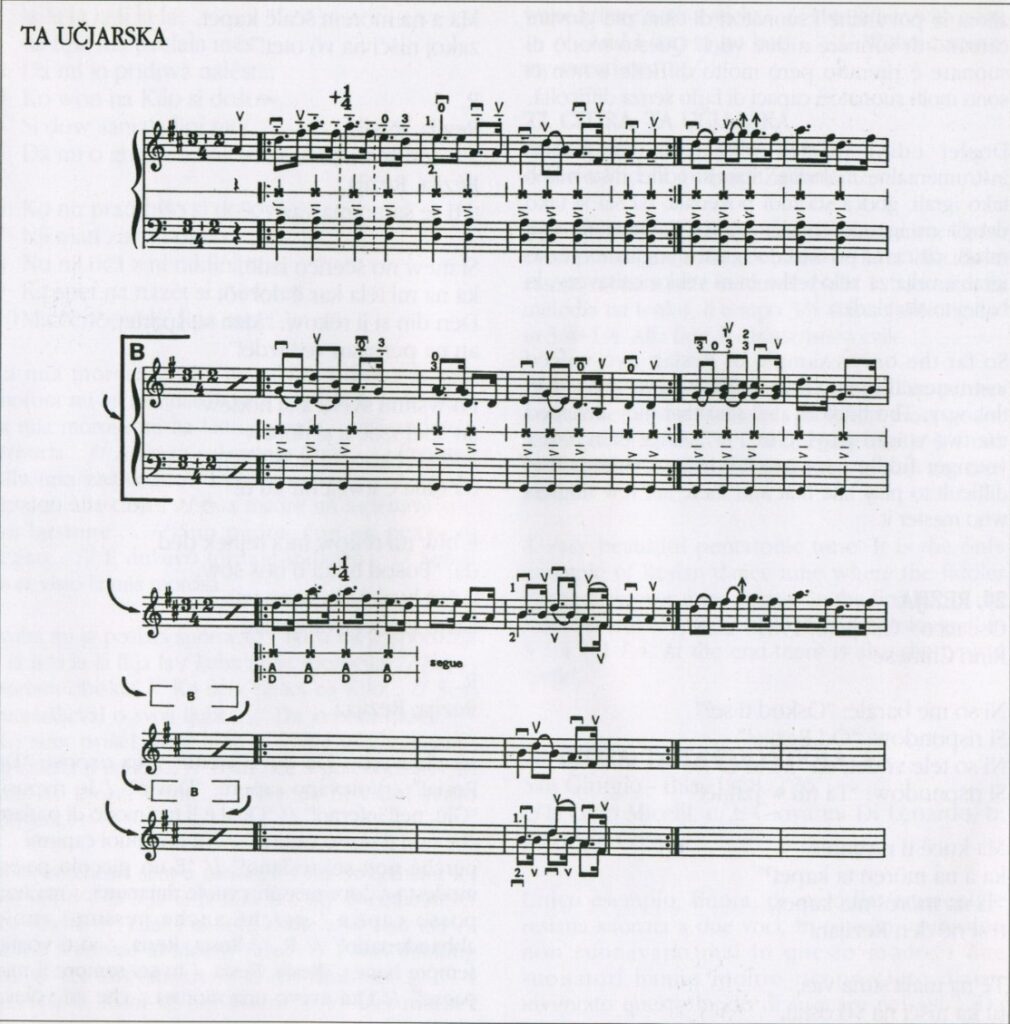

Recorded: San Giorgio, 1968, 2’36”
Performed by: Livio Micelli, Giovanni di Lenardo, Riccardo Coss
So far the only example of Resian two-voiced instrumental tune. Older fiddlers never played in this way. The fiddlers also said that they invented two-voiced playing in 1967. Since then, other younger fiddlers try to play in two voices. It is difficult to play this way, and there are few fiddlers who master it.
Recorded: Oseacco, 1981, 2’48”
Sung by: Rino Chinese
Ni so me barale: “Oskod ti se?”
Si rispondow: “Od Rezije!”
Ni so tele vëdet, da “kë to ë?”
Si rišpundow: “Ta nu w paklë”
Ma kucë ti romunïš,
ka ä na mören ta kape1?”
“Ti na möreš ma kapet,
ti si në dën Rezijan!”
Të na maja sïtna vas,
tu ka nišći na vö ostat,
Ma a na morem ščalë kapet,
zakoj nišči na vö otet!”
R.
Rezija, Rezija,
a ti čon šćale dobro!
Rezija, Rezija,
ti ti se samo ma vas!
Si mew no šćerïco izdë,
ka na mi tëla kar ë dobrö.
Den din si ji rëkow: “Man se špərtet,
an na perhaan već izdë!”
Po wsimu svëtu a si hodew
an spet izdë a si došew
anu si rëkow tu w iso hćï,
da nina e liwća nu ku tï!”
E biw mi rëkow möj rejnek dëd,
da: “Posod tu ka tï boš šow,
ti češ hvalet no samo vas,
isa to će bet twa Rezija!”
And they asked: “Where are you from?” I told them: “From Resia!” / They wanted to know: “Where is that?” / I replied: “Down there, in hell!” // “What kind of language is that / that I cannot understand you?” / “You cannot understand me / because you are not a Resian!” // “It is a small humble village / where no one wants to stay, / but I cannot understand / why no one wants to leave!” // Resia, Resia, / I will always love you. / Resia, Resia, / you will forever be my village!” // I had a sweetheart here, / who loved me very much, / I told her some day: “I am thinking of leaving / and will never come back” // I went all over the world, And came back again, and told my girl: / “No girl is prettier than you!” // My late grandfather told me, / that “wherever you go, / you will praise (love) only one village, and this will be your Resia!”
Resia is a beautiful mountainous valley in the Western Julian Alps on the ltalian side of the border, over which rules the powerful Kanin mountain range. The valley is a little over 20 kilometres long and only four kilometres at its widest. Resia is the name of the municipality and the local river, but there is no village of this name. Slovene tribes first settled here round about 7th century. Nowadays, the population numbers around 1,300 people, most of whom live in villages and hamlets. The biggest village is Ravanca / Prato, the seat of municipality and the administrative centre. Then there are larger villages such as Bila / San Giorgio, Liščaca / Lischiazze, Osojane / Oseacco, Solbica / Stolvizza and, just below Mount Kanin, Korito / Coritis and Učja / Uccea, which lies in the parallel valley. From the Slovene direction, you can reach Resia from the Žaga village in the Soča valley and over the mountain pass of the same name – Učja / Uccea, whilst from the Italian direction you can arrive to it from Tarcento. lts special geographical position has always made any regular and frequent contacts with the population on either side of the border difficult, and that is how the Resians were able to preserve their original cultural characteristics in dialect, singing, music and dance until this day. The Resians are known for a great love and respect for their tradition. They have retained their own, unique, homogeneous and archaic popular culture in almost unaltered manner, and their traditions remain alive even today, enjoyed equally by the old or by the young. For an ethnomusicologist or a linguist Resia remains a genuine treasure of curiosities you can hardly see anywhere else in ethnic Slovenia or even in Europe.
The first systematic ethnomusicological research in Resia started in 1962. That year two institutions – Centro Nazionale di musica popolare di Roma and the Institute of Ethnomusicology from Ljubljana agreed on joint research in Resia. The ltalian side was represented by a renown enthomusicologist Giorgio Nataletti and his colleagues. Valens Vodušek, Uroš Krek, Marija Šuštar and Milko Matičetov represented Slovenia. Their common research began in May 1962, but the following year (in 1963) it was decided that the Slovenes were to take over the entire research project. The Slovene group of researchers was reinforced in 1966 when Julijan Strajnar and Mirko Ramovš joined. The Resian folk tradition was also explored by others like Alan Lomax, Diego Carpitella, Roberto Leydi and Pavle Merkù.
The published examples are only a fraction of a very rich Resian tradition and include sound samples recorded between 1962 and 1996, so they cannnot be taken as the only “appropriate” ones because the creative force of Resia is still very much alive. The Resians have always been in love with their valley, many lyrical songs sing about mountain peaks and portray nature (e.g. 2, 3, 4, 16, 17). There are also love songs where the true meaning is often hidden in symbols, actually unpredictable ones, that only the Resians can understand (e.g. 14, 15). Some narrative songs preserve various archaic rarities, very uncommon anywhere else in Europe. They maintain the most primitive way of singing epic songs. The verse follows one after another in endless repetition of only one short tune of narrow range, as we can see from the first example. The subject of the song is similar to the Antique legend of Orpheus and Eurydice – salvation from hell – the underworld by means of music.
Most of their two- or three-voiced songs have a short one-part tune holding bourdon in lower voice (e.g. 3, 4). Relatively recent songs are sung in parallel terza which may well be influenced by the Slovene or Friulian way of singing. Yet these songs, too, are sung in their own way – the Resian way (e.g. 18, 23). It is also typical that the end of the song or during the dance they cheer jubilantly – as they say to “zajuhuhknot” – particularly women and much less men (e.g. 19).
Another great love of the Resians is the fiddle – citira. Citira is a colloquial expression for the fiddle, but it is not possible to fiddle – citirati on its own without an accompaniment. Citira must always be accompanied by another instrument, bunkula, the big citira or bos which is a small double bass or a violoncello with only three strings. The citira is no doubt the major instrument played by only the most skilled fiddlers – citiravci – while bunkula can be played by anyone, even women or children.
The essential element of playing – citiranje – is not only the melody and bourdon on bunkula, bul also hard stamping of the left or right foot of the fiddler. All fiddlers without exception tune their instrumems to an extraordinarily high pitch, at least a minor third higher than the usual violin tuning, so instead of g, d1, a 1, e2 they sound b, f, c1, g1. They always play in a sitting position, leaning their citira almost vertically against their chest, always in the first position, in fast rhythm quaver = 160. The most popular tunes in Resian vižice are in 3 + 2 / 4 measure. On average, every fiddler can play about 60 different dancing tunes which the Resians distinguish very well, but to an unaccustomed ear they may all sound very much alike if not the same. All tunes are single voiced, although since recent times several fiddlers play simultaneously, hence unisono. Only one dancing tune exists which is played in two voices (e.g. 28). The end of each tune comes as a great surprise when the fiddler draws against empty strings, G-D and the bukula player against G.
The music of the citira is exclusively a musical accompaniment to dance. It is hardly possible to play citira if there are no dancers. Resian dance is something exceptional. The dancers are arranged in unjoined pairs and they never embrace one another. Everyone dances alone, and the number of steps is not defined. The partners must be opposite each other – it does not matter what sex they are – and they change places throughout the dance. How many times they change places depends on the dancing tune. As a rule, the melody is repeated optionally (e.g. seven to nine times), the fiddler plays a part of the melody “na tenko” – in D major and “na tolsto” in G major. At the end of the melody “na tenko” all dancers stamp the right foot hard on the floor. Once the melody “na tenko” has been repeated three times, instead of twice, this is a sign that the tune – dance is over.
It is quite hard to understand how the Resians were able to preserve their original and genuine expression of music and dance.
Citira has been and remains the greatest love of the Resians. There is no doubt tbat the sound of this kind of music is to echo in Resia for many years to come. Every year young new fiddlers of citira emerge, successfully take over and continue tbe music tradition, creating new tunes (e.g. 20, 21, 22, 28). Rezija is the title of a song (e.g. 29) composed by author and musician Rino Chinese. The original lyrics in local dialect is based on a traditional song and tuned similarly to pop melodies accompanied by a guitar.
Resians are great travellers, as merchants and peddlers in the old days, or now as seasonal workers and emigrants. They all have an ear for music, they learn foreign languages, songs and dances very fast. When they return home they “romunijo” – speak in their own dialect and sing their local songs. Once they hear the sound of a citira and its catchy rhythm, they all dance in the same fashion, the old, the young and even the children.
I would like to express my gratitude to all who helped create the record. My great appreciation goes to the singers. dancers, fiddlers and to all our friends in Resia for their warm openness and hospitality who obligingly explained everything they knew. My special thanks to the translator Roben Dapit for his help in transcription and explanation of texts (3, 11, 12, 14 – 18, 24 – 26).
I am grateful to GNI wbo let me use the archives and, finally, I wisb to thank Valter Colle who published and printed the record. “My dear Resians! God be willing, you will live long and for many years to come, to fiddle and to sing !”
Julijan Strajnar
